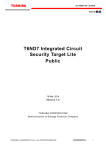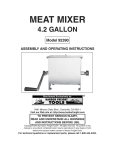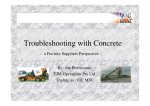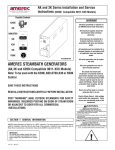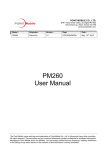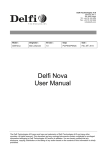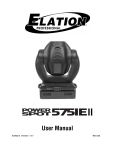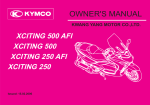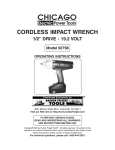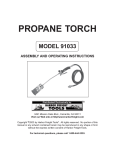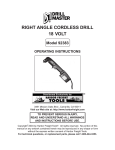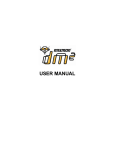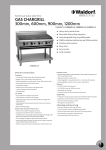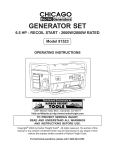Download Harbor Freight Tools 94683 User's Manual
Transcript
RECHARGEABLE BUG VACUUM Model 94683 ASSEMBLY AND OPERATING INSTRUCTIONS Due to continuing improvements, actual product may differ slightly from the product described herein. 3491 Mission Oaks Blvd., Camarillo, CA 93011 Visit our Web site at: http://www.harborfreight.com TO PREVENT SERIOUS INJURY, READ AND UNDERSTAND ALL WARNINGS AND INSTRUCTIONS BEFORE USE. Copyright © 2006 by Harbor Freight Tools®. All rights reserved. No portion of this manual or any artwork contained herein may be reproduced in any shape or form without the express written consent of Harbor Freight Tools. For technical questions, please call 1-800-444-3353. PRODUCT SPECIFICATIONS Item Electrical R equirem ents O verall Dim ensions Housing D im ensions Unit W eight Description Charger Pow er Input: 120VAC / 60 Hz Charger Pow er Output: 4.5VDC / 800m A Charger Pow er Cord Length: 6 Ft. Charger Pow er Plug Type: 2-Prong Power Switch Type: Toggle (O N/OFF) Rechargeable Battery Type: Ni-CD SC 2000m ah 3.6V – Approxim ate 20 m inute run time w hen fully charged Recharging LED Indicator Color: Red 34-1/2” Long x 3-3/4” O utside D iam eter 12-1/2” Long x 3-3/4” O utside D iam eter 2.20 Pounds SAVE THIS MANUAL You will need this manual for the safety warnings and precautions, assembly, operating, inspection, maintenance and cleaning procedures, parts list and assembly diagram. Keep your invoice with this manual. Write the invoice number on the inside of the front cover. Keep this manual and invoice in a safe and dry place for future reference. GENERAL SAFETY RULES IMPORTANT SAFETY INSTRUCTIONS WARNING! READ AND UNDERSTAND ALL INSTRUCTIONS Failure to follow all instructions detailed in this manual may result in serious personal injury. SAVE THESE INSTRUCTIONS WORK AREA 1. Keep your work area clean and well lit. Cluttered and dark work areas invite accidents. 2. Keep bystanders, children, and visitors away while operating the Bug Vacuum. Distractions can cause you to lose control. SKU 94683 For technical questions, please call 1-800-444-3353 PAGE 2 PERSONAL SAFETY 3. Stay alert. Watch what you are doing, and use common sense when operating a power tool. Do not use the Bug Vacuum while tired or under the influence of drugs, alcohol, or medication. A moment of inattention while operating power tools may result in serious personal injury. 4. Dress properly. Do not wear loose clothing or jewelry. Contain long hair. Keep your hair, clothing, and gloves away from moving parts. Loose clothes, jewelry, or long hair can be caught in moving parts. 5. Do not overreach. Keep proper footing and balance at all times. Proper footing and balance enables better control of the Bug Vacuum in unexpected situations. 6. Always wear eye protection. Wear ANSI approved safety impact goggles when using this product. TOOL USE AND CARE 7. Do not force the Bug Vacuum. Use the correct product for your application. The correct product will do the job better and safer at the rate for which it is designed. 8. Store idle tools and equipment out of reach of children and other untrained people. Tools and equipment are dangerous in the hands of untrained users. 9. Maintain the Bug Vacuum with care. Keep this product clean. A properly maintained tool is easier to control. Do not use damaged tools and equipment. Tag damaged tools and equipment “Do not use” until repaired. 10. Check for misalignment or binding of moving parts, loose or broken parts, and any other condition that may affect the Bug Vacuum’s operation. If damaged, have the Vacuum serviced before using. Many accidents are caused by poorly maintained tools and equipment. 11. Use only accessories that are recommended by the manufacturer for your model. Accessories that may be suitable for one product may become hazardous when used on another product. SERVICE 12. Product service must be performed only by qualified service technician. SKU 94683 For technical questions, please call 1-800-444-3353 PAGE 3 Service or maintenance performed by unqualified personnel could result in a risk of injury. 13. When servicing the Bug Vacuum, use only identical replacement parts. Follow instructions in the “Inspection, Maintenance, And Cleaning” section of this manual. Use of unauthorized parts or failure to follow maintenance instructions may create a risk of electric shock or injury. SPECIFIC SAFETY RULES 1. Maintain labels and nameplates on the Bug Vacuum. These carry important information. If unreadable or missing, contact Harbor Freight Tools for a replacement. 2. Use the right product for the job. There are certain applications for which this product was designed. Do not use small tools, equipment, or attachments to do the work of larger industrial tools, equipment, or attachments. Do not use this product for a purpose for which it was not intended. 3. Store idle tools. When not in use, store the Bug Vacuum in a clean, dry, safe location out of reach of children. 4. Use caution when disposing of harmful insects and spiders that can bite or sting. Dispose of insects and spiders immediately after using the Bug Vacuum. Always keep children and animals safely away when disposing of insects and spiders. 5. This product is designed for dry vacuuming only. Do not attempt to vacuum liquids with the Bug Vacuum. Do not attempt to vacuum corrosive or combustible materials with this product. 6. Make sure to clean the Mesh Screen (7) and Vacuum Filter (8) of the Bug Vacuum before each use. 7. Never leave the Bug Vaccum unattended. When finished using the Vacuum, empty the unit. Thoroughly clean the unit and store it in a clean, dry, safe location out of reach of children. 8. Do not use the Bug Vacuum with any of its openings blocked. Keep free of dirt, lint, hair, insects, and anything that may reduce the flow of air. 9. Do not use the Bug Vacuum to pick up anything that is burning or smoking, such as cigarettes, matches, or hot ashes. SKU 94683 For technical questions, please call 1-800-444-3353 PAGE 4 10. Do not use the Bug Vacuum without its Mesh Screen (7) or Vacuum Filter (8) in place. 11. Do not use the Bug Vacuum if it has been dropped, damaged, left outdoors, or immersed in liquid. 12. Avoid accidental falls. Use extra care when cleaning on stairways. 13. Do not vacuum toxic, carcinogenic, or other hazardous materials such as asbestos, arsenic, barium, beryllium, lead, pesticides, or other health endangering materials. 14. Do not expose the Bug Vacuum to rain. Store the unit indoors. 15. Do not handle the Charger (6) of this product with wet hands. Never plug the Charger into an electrical outlet while standing on a wet or damp surface. 16. Do not unplug the Charger (6) by pulling on its Power Cord. Do not pull or carry the Charger by its Power Cord. Keep the Power Cord away from sharp corners or edges. 17. WARNING! People with pacemakers should consult their physician(s) before using this product. Operation of electrical equipment in close proximity to a heart pacemaker could cause interference or failure of the pacemaker. 18. WARNING! The warnings and cautions discussed in this manual cannot cover all possible conditions and situations that may occur. It must be understood by the operator that common sense and caution are factors which cannot be built into this product, but must be supplied by the operator. SAVE THESE INSTRUCTIONS GROUNDING WARNING! Improperly connecting the grounding wire can result in the risk of electric shock. Check with a qualified electrician if you are in doubt as to whether the outlet is properly grounded. Do not modify the power cord plug provided with the tool. Never remove the grounding prong from the plug. Do not use the tool if the power cord or plug is damaged. If damaged, have it repaired by a service facility before use. If the plug will not fit the outlet, have a proper outlet installed by a qualified electrician. SKU 94683 For technical questions, please call 1-800-444-3353 PAGE 5 GROUNDED TOOLS: TOOLS WITH THREE PRONG PLUGS 1. Tools marked with “Grounding Required” have a three wire cord and three prong grounding plug. The plug must be connected to a properly grounded outlet. If the tool should electrically malfunction or break down, grounding provides a low resistance path to carry electricity away from the user, reducing the risk of electric shock. (See Figure A.) 2. The grounding prong in the plug is connected through the green wire inside the cord to the grounding system in the tool. The green wire in the cord must be the only wire connected to the tool’s grounding system and must never be attached to an electrically “live” terminal. (See Figure A.) 3. Your tool must be plugged into an appropriate outlet, properly installed and grounded in accordance with all codes and ordinances. The plug and outlet should look like those in the following illustration. (See Figure A.) THIS PRODUCT DOES NOT USE A 3-PRONG PLUG 120 VOLT ELECTRICAL OUTLET FIGURE A DOUBLE INSULATED TOOLS: TOOLS WITH TWO PRONG PLUGS 4. Tools marked “Double Insulated” do not require grounding. They have a special double insulation system which satisfies OSHA requirements and complies with the applicable standards of Underwriters Laboratories, Inc., the Canadian Standard Association, and the National Electrical Code. (See Figure B.) 5. Double insulated tools may be used in either of the 120 volt outlets shown in the following illustration. (See Figure B.) THIS PRODUCT USES A 2-PRONG PLUG 120 VOLT ELECTRICAL OUTLETS FIGURE B SKU 94683 For technical questions, please call 1-800-444-3353 PAGE 6 EXTENSION CORDS 1. Grounded tools require a three wire extension cord. Double Insulated tools can use either a two or three wire extension cord. 2. As the distance from the supply outlet increases, you must use a heavier gauge extension cord. Using extension cords with inadequately sized wire causes a serious drop in voltage, resulting in loss of power and possible tool damage. (See Figure C.) 3. The smaller the gauge number of the wire, the greater the capacity of the cord. For example, a 14 gauge cord can carry a higher current than a 16 gauge cord. (See Figure C.) 4. When using more than one extension cord to make up the total length, make sure each cord contains at least the minimum wire size required. (See Figure C.) 5. If you are using one extension cord for more than one tool, add the nameplate amperes and use the sum to determine the required minimum cord size. (See Figure C.) 6. Make sure your extension cord is properly wired and in good electrical condition. Always replace a damaged extension cord or have it repaired by a qualified electrician before using it. 7. Protect your extension cords from sharp objects, excessive heat, and damp or wet areas. RECOMMENDED MINIMUM WIRE GAUGE FOR EXTENSION CORDS* (120 VOLT) NAMEPLATE AMPERES (At Full Load) 0 – 2.0 2.1 – 3.4 3.5 – 5.0 5.1 – 7.0 7.1 – 12.0 12.1 – 16.0 16.1 – 20.0 FIGURE C SKU 94683 EXTENSION CORD LENGTH 25 50 75 Feet Feet Feet 18 18 18 18 18 18 18 18 16 18 16 14 18 14 12 14 12 10 12 10 * Based on limiting the line voltage drop to five volts at 150% of the rated amperes. 100 Feet 18 16 14 12 10 - For technical questions, please call 1-800-444-3353 150 Feet 16 14 12 12 - PAGE 7 SYMBOLOGY FIGURE D UNPACKING When unpacking, check to make sure all the parts shown in the Parts List on page 12 are included. If any parts are missing or broken, please call Harbor Freight Tools at the number shown on the front cover of this manual as soon as possible. PRE-OPERATING INSTRUCTIONS To Charge The Internal Battery: 1. The Battery for the Bug Vacuum must be fully charged before using the tool. When charging for the first time, and all subsequent charges, the charge time is 14 to 16 hours. Never charge the Battery for longer than 16 hours, as damage to the Battery and/or Vacuum will occur. Approximate 20 minute run time when fully charged. 2. To charge the Battery, turn the Power Switch to its “OFF” position. 3. Insert the Charging Plug of the Charger (6) into the Charging Receptacle of the Vacuum (1). (See Figure E, next page.) 4. Plug the Power Cord Plug of the Charger (6) into the nearest, 120 volt, grounded, electrical outlet. The RED LED light on the Charger will illuminate, indicating the Battery is being charged. (See Figure E.) 5. Charge the Battery for 14 to 16 hours. IMPORTANT: The Charger (6) will not SKU 94683 For technical questions, please call 1-800-444-3353 PAGE 8 automatically shut off when the Battery is fully charged. Avoid Battery/tool damage by removing power to the Charger at the end of 14 to 16 hours charge time. (See Figure E.) 6. When finished charging, disconnect the Charger (6) from the electrical outlet. Then, remove the Charging Plug of the Charger from the Charging Receptacle of the Vacuum (1). (See Figure E.) VACUUM (1) CHARGER (6) CHARGING RECEPTACLE 120 VOLT, GROUNDED, ELECTRICAL OUTLET CHARGING PLUG FIGURE E ASSEMBLY AND OPERATING INSTRUCTIONS To Use As A Vacuum: Crevice Tool (4) Extension Tube (3) OR Extension Tube (3) Vacuum (1) FIGURE F To Use As A Bug Vacuum: Bug Chamber (2) Wide Bug Catcher (5) Extension Tube (3) Mesh Screen (7) Vacuum (1) FIGURE G SKU 94683 For technical questions, please call 1-800-444-3353 PAGE 9 Directions For Bug Disposal: 1. Fire hazard: Do not spray pesticides or other flammable agents into the Bug Vacuum during use. Allow all pesticides, if used, to dry before using the Vacuum. WIDE BUG CATCHER (5) VACUUM (1) BUG CHAMBER (2) TIP THIS END TO DISPOSE OF INSECTS EXTENSION TUBE (3) FIGURE H TROUBLESHOOTING Problem Tool does not turn on. Possible Solution 1. Make sure the Power Switch is in its “ON” position. 2. Make sure to plug the Charger into a working, 120 volt, grounded, electrical outlet. 3. Make sure to charge the Battery fully from 14 to 16 hours. Tool turns on, but has little or no suction. 4. Have a qualified service technician check out the tool. 1. Make sure to charge the Battery fully from 14 to 16 hours. 2. Make sure all connections are tight. 3. Make sure no openings in the tool are clogged. 4. Make sure the Vacuum Filter and/or Mesh Screen is clean. 5. Have a qualified service technician check out the tool. SKU 94683 For technical questions, please call 1-800-444-3353 PAGE 10 INSPECTION, MAINTENANCE, AND CLEANING 1. CAUTION! Make sure the Power Switch is in its “OFF” position and unplugged from its Charger (6) before performing any inspection, maintenance, or cleaning of the Bug Vacuum. 2. Before each use, inspect the general condition of the Bug Vacuum. Check for misalignment or binding of moving parts, damaged or loose parts, dirt or debris in the Vacuum Filter and Mesh Screen, damaged electrical wiring, and any other condition that may affect the tool’s safe operation. If abnormal noise or vibration occurs, have the problem corrected before further use. Do not use damaged equipment. 3. To clean: Flush the interior and clean the exterior of the Bug Vacuum accessories with a mild detergent. Then, allow to air-dry. Do not use solvents. Do not immerse the Vacuum (1) in liquids. 4. When storing: Always completely empty the Bug Vacuum of dirt, debris, and insects. Make sure to store the Bug Vacuum and its accessories in a safe, dry, clean location out of reach of children and other unauthorized people. 5. To remove the internal NiCd battery: A technician should unthread the front portion of the Vacuum (1) and set it aside. Then, the four screws in the rear portion should be removed. The battery pack can then be removed and a replacement installed and sauter-connected to the wires. Always dispose of or recycle used NiCd batteries properly. For information on free battery recycling, please call 1-800-444-3353. 6. CAUTION! All maintenance, service, and repairs not discussed in this manual should only be performed by a qualified service technician. PLEASE READ THE FOLLOWING CAREFULLY THE MANUFACTURER AND/OR DISTRIBUTOR HAS PROVIDED THE PARTS LIST AND ASSEMBLY DIAGRAM IN THIS MANUAL AS A REFERENCE TOOL ONLY. NEITHER THE MANUFACTURER OR DISTRIBUTOR MAKES ANY REPRESENTATION OR WARRANTY OF ANY KIND TO THE BUYER THAT HE OR SHE IS QUALIFIED TO REPLACE ANY PARTS OF THE PRODUCT. IN FACT, THE MANUFACTURER AND/OR DISTRIBUTOR EXPRESSLY STATES THAT ALL REPAIRS AND PARTS REPLACEMENTS SHOULD BE UNDERTAKEN BY CERTIFIED AND LICENSED TECHNICIANS, AND NOT BY THE BUYER. THE BUYER ASSUMES ALL RISKS AND LIABILITY ARISING OUT OF HIS OR HER REPAIRS TO THE ORIGINAL PRODUCT OR REPLACEMENT PARTS THERETO, OR ARISING OUT OF HIS OR HER INSTALLATION OF REPLACEMENT PARTS THERETO. REV 08/06 SKU 94683 For technical questions, please call 1-800-444-3353 PAGE 11 PARTS LIST AND ASSEMBLY DIAGRAM Part # 1 2 3 4 Description Vacuum Bug Chamber Extension Tube Crevice Tool Qty. 1 1 2 1 Part # 5 6 7 8 Discription Wide Bug Catcher Charger Mesh Screen Vacuum Filter Qty. 1 1 2 2 2 1 3 8 6 7 3 4 5 NOTE: Some parts are listed and shown for illustration purposes only, and are not available individually as replacement parts. SKU 94683 For technical questions, please call 1-800-444-3353 PAGE 12












